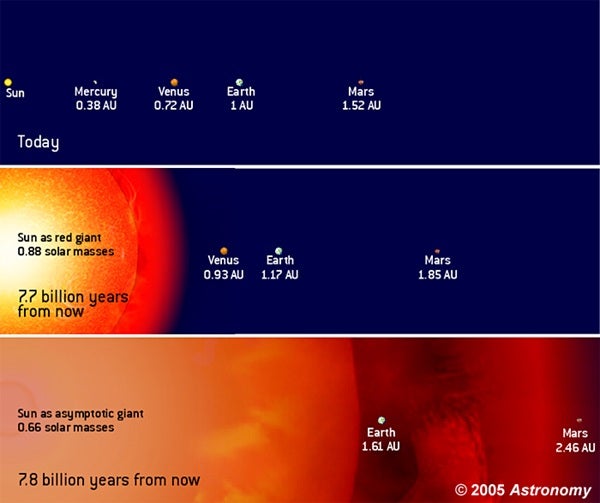The Sun will quickly exhaust its helium and swell into a larger red giant as it enters its “asymptotic giant branch” phase. Matter more easily escapes the red giant Sun. Soon after becoming an asymptotic giant, the Sun will eject much of its remaining mass in a planetary nebula. It will leave behind a tiny white dwarf containing only about half the Sun’s present mass.
So, what happens to the planets of the solar system as the Sun swells and loses mass? If the Sun were to lose half of its mass instantly, the planets would all fly off into deep space because the Sun’s gravity would be too weak to retain them. This won’t happen because the mass-loss processes described above occur over billions of years.
Although the planets will stay bound to the Sun, they will move farther away from it because of the Sun’s decreased mass and weaker gravity. This phenomenon is known as adiabatic expansion of the planets’ orbits.
The fate of the outer planets is pretty straightforward. Computer simulations show bodies from Jupiter out through the Kuiper Belt will remain bound to the white-dwarf Sun. They will orbit it for the billions of years it will take for the Sun’s light to wane and, ultimately, fail completely.
The fate of the inner planets is less certain. Although the asymptotic giant Sun will bloat outward to near the current orbit of Mars, the Sun’s mass loss will swell the orbits of the inner planets, too. Mercury will be swallowed by the Sun during its first red giant phase. Venus may survive the first phase, but will be consumed during the second giant phase. In all but the direst scenarios, Mars will survive the Sun’s final stages of evolution.
Earth’s fate depends on precise details of the Sun’s evolution and mass loss, none of which are known. Earth will likely survive the Sun’s first round of expansion; but in the second giant phase, the Sun’s surface grazes Earth’s final orbit. Because the Sun’s outer layers will have low density, and because the giant phase lasts only a few million years, it’s even possible Earth could end up orbiting inside the Sun without being completely destroyed. — KURTIS A. WILLIAMS, STEWARD OBSERVATORY, TUCSON, ARIZONA










